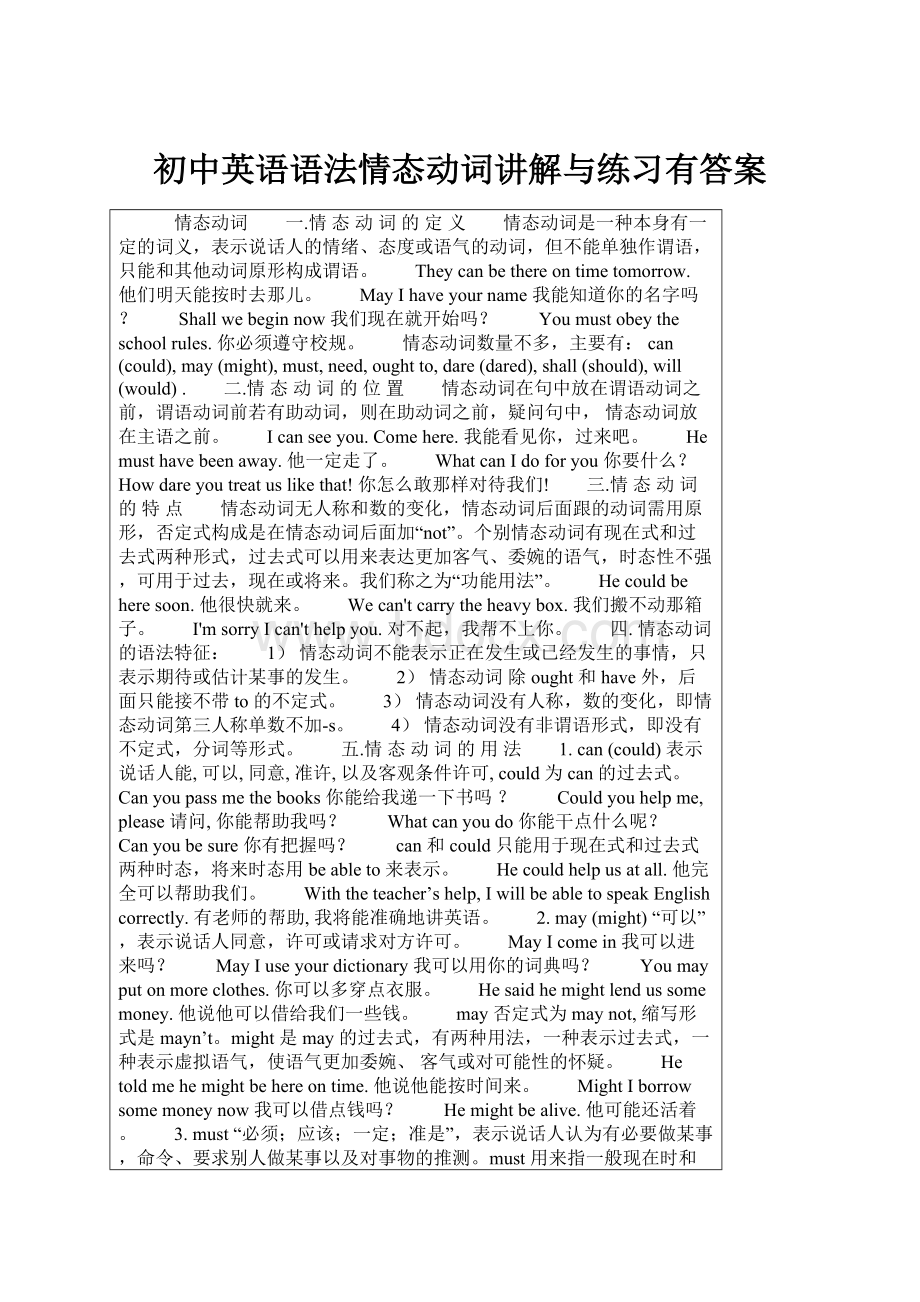 初中英语语法情态动词讲解与练习有答案.docx
初中英语语法情态动词讲解与练习有答案.docx
- 文档编号:9497541
- 上传时间:2023-02-05
- 格式:DOCX
- 页数:7
- 大小:23.41KB
初中英语语法情态动词讲解与练习有答案.docx
《初中英语语法情态动词讲解与练习有答案.docx》由会员分享,可在线阅读,更多相关《初中英语语法情态动词讲解与练习有答案.docx(7页珍藏版)》请在冰豆网上搜索。

初中英语语法情态动词讲解与练习有答案
情态动词 一.情态动词的定义 情态动词是一种本身有一定的词义,表示说话人的情绪、态度或语气的动词,但不能单独作谓语,只能和其他动词原形构成谓语。
Theycanbethereontimetomorrow.他们明天能按时去那儿。
MayIhaveyourname我能知道你的名字吗?
Shallwebeginnow我们现在就开始吗?
Youmustobeytheschoolrules.你必须遵守校规。
情态动词数量不多,主要有:
can(could),may(might),must,need,oughtto,dare(dared),shall(should),will(would). 二.情态动词的位置 情态动词在句中放在谓语动词之前,谓语动词前若有助动词,则在助动词之前,疑问句中,情态动词放在主语之前。
Icanseeyou.Comehere.我能看见你,过来吧。
Hemusthavebeenaway.他一定走了。
WhatcanIdoforyou你要什么?
Howdareyoutreatuslikethat!
你怎么敢那样对待我们!
三.情态动词的特点 情态动词无人称和数的变化,情态动词后面跟的动词需用原形,否定式构成是在情态动词后面加“not”。
个别情态动词有现在式和过去式两种形式,过去式可以用来表达更加客气、委婉的语气,时态性不强,可用于过去,现在或将来。
我们称之为“功能用法”。
Hecouldbeheresoon.他很快就来。
Wecan'tcarrytheheavybox.我们搬不动那箱子。
I'msorryIcan'thelpyou.对不起,我帮不上你。
四.情态动词的语法特征:
1)情态动词不能表示正在发生或已经发生的事情,只表示期待或估计某事的发生。
2)情态动词除ought和have外,后面只能接不带to的不定式。
3)情态动词没有人称,数的变化,即情态动词第三人称单数不加-s。
4)情态动词没有非谓语形式,即没有不定式,分词等形式。
五.情态动词的用法 1.can(could)表示说话人能,可以,同意,准许,以及客观条件许可,could为can的过去式。
Canyoupassmethebooks你能给我递一下书吗?
Couldyouhelpme,please请问,你能帮助我吗?
Whatcanyoudo你能干点什么呢?
Canyoubesure你有把握吗?
can和could只能用于现在式和过去式两种时态,将来时态用beableto来表示。
Hecouldhelpusatall.他完全可以帮助我们。
Withtheteacher’shelp,IwillbeabletospeakEnglishcorrectly.有老师的帮助,我将能准确地讲英语。
2.may(might)“可以”,表示说话人同意,许可或请求对方许可。
MayIcomein我可以进来吗?
MayIuseyourdictionary我可以用你的词典吗?
Youmayputonmoreclothes.你可以多穿点衣服。
Hesaidhemightlendussomemoney.他说他可以借给我们一些钱。
may否定式为maynot,缩写形式是mayn’t。
might是may的过去式,有两种用法,一种表示过去式,一种表示虚拟语气,使语气更加委婉、客气或对可能性的怀疑。
Hetoldmehemightbehereontime.他说他能按时间来。
MightIborrowsomemoneynow我可以借点钱吗?
Hemightbealive.他可能还活着。
3.must“必须;应该;一定;准是”,表示说话人认为有必要做某事,命令、要求别人做某事以及对事物的推测。
must用来指一般现在时和一般将来时,过去式可用haveto的过去式代替。
Imustfinishmyworktoday.我今天必须完成我的工作。
Youmustn'tworkallthetime.你不能老是工作。
MustIreturnthebooktomorrow我必须明天还书吗?
Aftersuchalongwalk,youmustbetired.走了这么长的路,你一定累了。
HemustbethemanIamlookingfor.他一定是我要找的人。
Hehadtogobecauseofsomebody’scallinghimthatday.那天他要走,因为有人叫他。
值得注意的是:
(1)must+have+过去分词,表示现在对过去事物的推测。
Hemusthavetoldmyparentsaboutit. 他一定把这件事情告诉我父母亲了。
It'ssixo'clockalready,wemusthavebeenlateagain. 已经六点钟了,我们一定又迟到了。
(2)must和haveto的区别:
must表示说话人的主观思想,haveto“不得不,必须”,表示客观需要、客观条件只能如此。
Youmustdoitnow.你必需现在就干。
(说话人认为必须现在干) Ihavetogonow.我得走了。
(客观条件必须现在走) Youmustbehereontimenexttime.你下次一定要按时来。
Ihavetocookformychild.我得给孩子做饭。
4.need“需要”,多用在否定式或疑问句中. NeedIattendthemeetingtomorrow我需要明天参加会议吗?
Youneednothandinthepaperthisweek.这一周你不必交论文。
need是一个情态动词,他的用法完全和其他情态动词一样,但need还可当作实义动词使用,这时need就象其他动词一样,有第三人称,单复数,后面加带to的动词等特性。
Ineedabiketogotoschool.我上学需要一辆自行车。
Doyouneedadictionary你需要词典吗?
Sheneedsanecklace.她需要一条项链。
注意:
“needn‘t+have+过去分词”表示过去做了没必要做的事情。
Youneedn'thavetakenitseriously.这件事情你不必太认真。
5.dare“敢”,多用在否定或疑问句中。
Thelittlegirldarenotspeakinpublic.小女孩不敢在公众面前说话。
Dareyoucatchthelittlesnake你敢抓小蛇吗?
dare除用作情态动词外,更多的是当实义动词使用,用法同实义动词一样,要考虑人称,单复数,时态等。
Doyoudaretowalkinthedark你敢黑夜走路吗?
Hedoesn'tdaretotelltheteacherwhathappenedthatday.他不敢告诉老师那天发生的事。
6.ought“应当;应该”,后面跟带有to的动词不定式。
Yououghttoreadthesebooksifyouwanttoknowhowtorepairthemotorcar.如果你想知道如何修理汽车,你应该读这些书。
Yououghttobringthechildhere.你应该把孩子带来。
ought+tohavedone句型。
指过去动作,表示一件事情该做而未做。
Yououghttohavebeenhereyesterday.你昨天就应该来。
oughtnottohavedone句型。
表示一件不该做的事情却做了。
Yououghtnottohavetakenthebookoutofthereading-room. 你不应该把书带出阅览室。
7.will(would)表决心、愿望。
would为will的过去式,可用于各人称。
1)will表示经常性、习惯性、倾向性,would表示过去的习惯行为。
.a.Hewillsittherehourafterhourlookingatthetrafficgoby. wouldcometoseemewhenhewasinBeijing. 2)表示意志,决心或愿望。
.a.Surelywewillsupportallthepeopleintheworldintheirstruggleforpeace. b.Hewouldnotletmetryit. 3)表示对对方的请求,用于第二人称作主语的疑问句中,would的语气比will委碗,疑问句中一般用some,而不是any。
.a.would/willyoukindlytellmethewaytothestation?
b.Wouldyoulikesomecake?
4)wouldlike=wantto想要 Wouldliketodo=wanttodo想要 e.g.aWouldyouliketogowithme?
8.shall,should表示命令,警告,允诺,征求,劝告,建议,惊奇等。
shall的用法 用于第一,第三人称征求对方的意愿 .a.WhatshallIwearonthejourney?
b.Whenshallhebeabletoleavethehospital?
should的用法 1)用于第一人称疑问句中询问对方的意愿,但语气较委婉温和 .a.Whatshouldwedonow我们现在该怎么办?
2)表示应该、必须,常与must换用。
.a.Weshould(must)masteraforeignlanguageatleast. 3).should表示劝告,建议,命令,此时也可用oughtto.在疑问句中,通常用should代替oughtto. 4)shouldhavedone表示过去应该做而实际没有做 shouldnothavedone表示过去不该做而实际做了. 9.haveto&must 1) 两词都是'必须'的意思,haveto表示客观的需要,must表示说话人主观上的看法,既主观上的必要。
.a.Mybrotherwasveryill,soIhadtocallthedoctorinthemiddleofthenight.(客观上需要做这件事) b.Hesaidthattheymustworkhard.(主观上要做) 2) haveto有人称、数、时态的变化,而must只有一种形式。
但must可用于间接引语中表示过去的必要或义务。
.a.Hehadtolookafterhissisteryesterday. 3)在否定结构中:
don’thaveto 表示“不必”mustn’t 表示“禁止” .a.Youdon‘thavetotellhimaboutit. b.Youmustn‘ttellhimaboutit. &dare 这两词既可做实义动词用,又可做情态动词用。
作为情态动词,两者都只能用于疑问句,否定句和条件句。
need作实义动词时后面的不定式必须带to,而dare作实义动词用时,后面的to时常可以被省略。
1)实义动词:
need+n./todosth 2)情态动词:
need,只用原形need后加do,否定形式为neednot。
.a.----Needyougoyet?
----Yes,Imust.\No,Ineedn't. 3)need的被动含义:
need,want,require,worth(形容词)后面接doing也可以表示被动:
needdoing=needtobedone 和oughtto都为“应该”的意思,可用于各种人称。
---Oughthetogo?
---Yes.Ithinkheoughtto. 表示要求,命令时,语气由should(应该)、hadbetter最好)、must(必须)渐强。
better表示"最好" hadbetter相当于一个助动词,它只有一种形式,它后面要跟动词原形。
hadbetterdosth.hadbetternotdoItisprettycold.You'dbetterputonmycoat. She'dbetternotplaywiththedog. hadbetterhavedonesth表示与事实相反的结果,意为"本来最好"。
Youhadbetterhavecomeearlier. 六.情态动词的回答方式 问句 肯定回答 否定回答 Needyou…Yes,Imust. No,Ineedn‘t Mustyou…Yes,Imust.No,Ineedn’t. /don’thaveto. MayI…Yes,ofcourse.No,youmustn’t. Couldyou…Yes,youcan.No,youcan’t.回答时千万不能用Yes,youcould.No,youcouldn’t. 七.情态动词表猜测 must用于肯定句 can 用于否定句或疑问句 May 用于肯定句或否定句 should 用于肯定句 八.表示推测的用法 can,could,may,might,must皆可表示推测,其用法如下:
1)情态动词+动词原形。
表示对现在或将来的情况的推测,此时动词通常为系动词。
Idon'tknowwheresheis,shemaybeinWuhan. 2)情态动词+动词现在进行时。
表示对现在或将来正在进行的情况进行推测。
Atthismoment,ourteachermustbecorrectingourexampapers. 这时,我们老师想必在批改试卷 3)情态动词+动词完成时。
表示对过去情况的推测。
WewouldhavefinishedthisworkbytheendofnextDecember.明年十二月底前我们很可能已完成这项工作了。
Theroadiswet.Itmusthaverainedlastnight.地是湿的,昨天晚上一定下雨了。
4)情态动词+动词的现在完成进行时。
表示对过去正在发生事情的推测。
Yourmothermusthavebeenlookingforyou.你妈妈一定一直在找你。
5)推测的否定形式,疑问形式用can't,couldn't表示。
Mikecan'thavefoundhiscar,forhecametoworkbybusthismorning. 迈克一定还没有找回他的车,因为早上他是坐公共汽车来上班的。
注意:
could,might表示推测时不表示时态,其推测的程度不如can,may。
九.情态动词+have+过去分词 1)may(might)have+donesth,can(could)have+donesth表示过去,推测过去时间里可能发生的事情。
Philipmay(might)havebeenhurtseriouslyinthecarcan(could)havebeenhurtseriouslyinthecaraccident. 2) musthave+donesth,对过去时间里可能发生的事情的推测,语气较强,具有"肯定","谅必"的意思。
- --Lindahasgonetowork,butherbicycleisstillhere. ---Shemusthavegonebybus. 3)oughttohavedonesth,shouldhavedonesth.本应该做某事,而事实上并没有做。
否定句表示"不该做某事而做了"。
Yououghtto(should)havebeenmorecarefulinthisexperiment.Heoughtnottohavethrowntheoldclothesaway.(事实上已扔了。
) oughtto在语气上比should要强。
4)needn'thavedonesth 本没必要做某事 Idressedverywarmlyforthetrip,butI needn'thavedoneso.Theweatherwashot. 5)wouldliketohavedonesth 本打算做某事 Iwouldliketohavereadthearticle,butIwasverybusythen. 十.带to的情态动词 带to的情态动词有四个:
oughtto,haveto,usedto,beto,如加上havegotto,(=must),beableto为六个,它们的疑问,否定形式应予以注意:
Dotheyhavetopaytheirbillbeforetheendofthemonth?
Shedidn‘tusetoplaytennisbeforeshewasfourteen. Yououghtnottohavetoldherallaboutit. Oughthetoseeaheartspecialistatonce.?
例:
Tomoughtnotto___meyoursecret,buthemeantnoharm. told telling D.havingtold
一.【语法过关】基础巩固(附答案)
1.— ______Ifillinthecheck-informrightnow,sir
—No,youneedn’t.Youcancompleteitthisafternoon.
A.May B.Can C.Would D.Must
2.—CouldIgotothemoviethisweekend,Dad
一Yes,you____.Butyouhavetocomebackbeforenine.
A.shallB.mustC.needD.can
3.Youplaywithfire,Tom.It'sdangerous.
A.needn'tB.maynotC.mustn'tD.wouldn't
4.Asweknow,fish___dieoutof water.
A.may B.isgoingto C.can D.will
5.—ShallIbooksomeseatsfortheconcert
—_____________.I’vealreadydonethat.
A.Yes,youmayB.No,youmustn’tC.No,youneedn’tD.I’drathernot
6.—IthinkMissGaomustbeinthelibrary.Shesaidshewouldgothere.
—No,she________bethere.I'vejustseenherthere.
A.can'tB.mustn'tC.needn'tD.wouldn't
7.You______worryabouthim.Hewillgetwellsoon.
A.needn'tB.can'tC.mustn'tD.maynot
8.Schools_____allowstudentsatleastonehouradayforsports.
A.wouldB.mightC.shouldD.could
9.You___openthedoorbeforethetraingetsintothestation.
A.don'thavetoB.mustn'tC.needn'tD.maynot
10.—Iwastoldtobeherebeforeeight.
—Oh,you.I’msorryfornottellingyouthatwehavechangedtheplan.
A.mustB.can’tC.mayD.needn’t
11.—MayItakethisbookoutofthereadingroom
—.Pleasereadithere.
A.CertainlyB.No,youneedn’tC.No,youmustn’t
12.—Who’sthatwomanwithAnn
—I’mnotsure.Itbehermother
A,mayB,canC,willD,must
13.—MustIgetupearlytomorrow—No,________.
A.youmustn’t B.Idon’tthinkyouhavetoC.youcan’t D.youneed
14.—Theroomissodirty.
- 配套讲稿:
如PPT文件的首页显示word图标,表示该PPT已包含配套word讲稿。双击word图标可打开word文档。
- 特殊限制:
部分文档作品中含有的国旗、国徽等图片,仅作为作品整体效果示例展示,禁止商用。设计者仅对作品中独创性部分享有著作权。
- 关 键 词:
- 初中英语 语法 情态 动词 讲解 练习 答案
 冰豆网所有资源均是用户自行上传分享,仅供网友学习交流,未经上传用户书面授权,请勿作他用。
冰豆网所有资源均是用户自行上传分享,仅供网友学习交流,未经上传用户书面授权,请勿作他用。


 1212中级汽车维修工考试试题三.docx
1212中级汽车维修工考试试题三.docx
